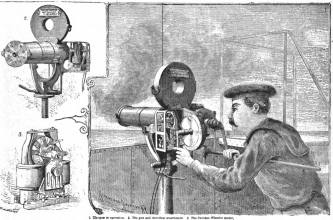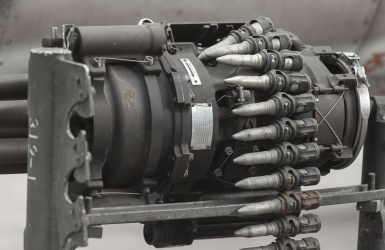Difference between revisions of "M61 (20 mm)"
m (→Pros and cons) (Tag: Visual edit) |
m (Section Desc + Template/Category Removal) |
||
| (4 intermediate revisions by 2 users not shown) | |||
| Line 4: | Line 4: | ||
=== Vehicles equipped with this weapon === | === Vehicles equipped with this weapon === | ||
| − | + | ''List out vehicles that are equipped with the weapon.'' | |
| − | |||
| − | |||
| − | |||
| − | |||
| − | |||
| − | |||
| − | |||
| − | |||
| − | |||
| − | |||
== General info == | == General info == | ||
| Line 27: | Line 17: | ||
* '''Default:''' {{Annotation|HEF-I|High-explosive fragmentation incendiary}}{{-}}{{Annotation|API-T|Armour-piercing incendiary tracer}}{{-}}{{Annotation|AP-I|Armour-piercing incendiary}} | * '''Default:''' {{Annotation|HEF-I|High-explosive fragmentation incendiary}}{{-}}{{Annotation|API-T|Armour-piercing incendiary tracer}}{{-}}{{Annotation|AP-I|Armour-piercing incendiary}} | ||
* '''Air targets:''' {{Annotation|HEF-I|High-explosive fragmentation incendiary}}{{-}}{{Annotation|HEF-I|High-explosive fragmentation incendiary}}{{-}}{{Annotation|API-T|Armour-piercing incendiary tracer}}{{-}}{{Annotation|HEF-I|High-explosive fragmentation incendiary}}{{-}}{{Annotation|HEF-I|High-explosive fragmentation incendiary}}{{-}}{{Annotation|AP-I|Armour-piercing incendiary}} | * '''Air targets:''' {{Annotation|HEF-I|High-explosive fragmentation incendiary}}{{-}}{{Annotation|HEF-I|High-explosive fragmentation incendiary}}{{-}}{{Annotation|API-T|Armour-piercing incendiary tracer}}{{-}}{{Annotation|HEF-I|High-explosive fragmentation incendiary}}{{-}}{{Annotation|HEF-I|High-explosive fragmentation incendiary}}{{-}}{{Annotation|AP-I|Armour-piercing incendiary}} | ||
| − | * '''Armored targets:''' {{Annotation| | + | * '''Armored targets:''' {{Annotation|AP-I|Armour-piercing incendiary}}{{-}}{{Annotation|API-T|Armour-piercing incendiary tracer}}{{-}}{{Annotation|AP-I|Armour-piercing incendiary}}{{-}}{{Annotation|AP-I|Armour-piercing incendiary}}{{-}}{{Annotation|HEF-I|High-explosive fragmentation incendiary}} |
* '''Stealth:''' {{Annotation|HEF-I|High-explosive fragmentation incendiary}}{{-}}{{Annotation|AP-I|Armour-piercing incendiary}}{{-}}{{Annotation|AP-I|Armour-piercing incendiary}} | * '''Stealth:''' {{Annotation|HEF-I|High-explosive fragmentation incendiary}}{{-}}{{Annotation|AP-I|Armour-piercing incendiary}}{{-}}{{Annotation|AP-I|Armour-piercing incendiary}} | ||
| Line 69: | Line 59: | ||
'''Cons:''' | '''Cons:''' | ||
| − | * | + | * Doesn't shoot instantly; it has a short spool up time before rounds start flying which may lead to missed shots in a short firing windows |
== History == | == History == | ||
| Line 101: | Line 91: | ||
== External links == | == External links == | ||
| − | <!--''Paste links to sources and external resources, such as:'' | + | <!-- ''Paste links to sources and external resources, such as:'' |
* ''topic on the official game forum;'' | * ''topic on the official game forum;'' | ||
| − | * ''other literature.''--> | + | * ''other literature.'' --> |
| − | ===References=== | + | === References === |
;Citations: | ;Citations: | ||
| Line 114: | Line 104: | ||
* Pike, John and Robert Sherman. 2000. "GAU-4 20mm Vulcan M61A1/M61A2 20mm Automatic Gun." FAS Military Analysis Network. Last modified April 23, 2000. [https://man.fas.org/dod-101/sys/ac/equip/m61.htm Webpage] ([https://web.archive.org/web/20220107030147/https://man.fas.org/dod-101/sys/ac/equip/m61.htm Archive]). | * Pike, John and Robert Sherman. 2000. "GAU-4 20mm Vulcan M61A1/M61A2 20mm Automatic Gun." FAS Military Analysis Network. Last modified April 23, 2000. [https://man.fas.org/dod-101/sys/ac/equip/m61.htm Webpage] ([https://web.archive.org/web/20220107030147/https://man.fas.org/dod-101/sys/ac/equip/m61.htm Archive]). | ||
* Wahl, Paul and Don Toppel. 1965. ''The Gatling Gun''. New York: Arco Publishing Company Inc. | * Wahl, Paul and Don Toppel. 1965. ''The Gatling Gun''. New York: Arco Publishing Company Inc. | ||
| − | |||
| − | |||
| − | |||
| − | |||
| − | |||
| − | |||
| − | |||
| − | |||
| − | |||
Latest revision as of 11:31, 4 October 2022
Contents
Description
The 20 mm M61 is an American rotary cannon used in their jet aircraft. Renowned for its high rate of fire, the M61 became the standard gun armament for American jet aircraft for many years since its adoption.
Vehicles equipped with this weapon
List out vehicles that are equipped with the weapon.
General info
The 20 mm M61 can bring an unprecedented amount of firepower to any jets equipped with it. At almost 6,000 rounds per minute, the weapon can very easily tear apart both air and ground target. The high rate of fire also ensures that in the event one round hits the target, multiple will also be landed in the same area.
Planes can be easily destroyed with the contact of one 20 mm shell, not mentioning the very rapid follow-up hits the M61 can deliver with a single burst. Ground targets up to light pillboxes are also easily destroyed by the 20 mm shells.
Available ammunition
- Default: HEF-I · API-T · AP-I
- Air targets: HEF-I · HEF-I · API-T · HEF-I · HEF-I · AP-I
- Armored targets: AP-I · API-T · AP-I · AP-I · HEF-I
- Stealth: HEF-I · AP-I · AP-I
| Penetration statistics | ||||||
|---|---|---|---|---|---|---|
| Belt | Penetration @ 0° Angle of Attack (mm) | |||||
| 10 m | 100 m | 500 m | 1,000 m | 1,500 m | 2,000 m | |
| Default | 53 | 50 | 39 | 28 | 20 | 14 |
| Air targets | 53 | 50 | 39 | 28 | 20 | 14 |
| Armored targets | 53 | 50 | 39 | 28 | 20 | 14 |
| Stealth | 53 | 50 | 39 | 28 | 20 | 14 |
Comparison with analogues
The most comparable weapon to the M61, aside from other M61 variants, is the Soviet 30 mm GSh-6-30.
Usage in battles
Describe the cannon/machine gun in the game - its distinctive features, tactics of usage against notable opponents. Please don't write a "guide" - do not impose a single point of view, but give the reader food for thought.
Pros and cons
Pros:
- Blisteringly high rate of fire at 6,000 RPM
- Accurate even through prolonged bursts
- Can fire off close to 1,100 rounds continuously in one burst before jamming
- API rounds can destroy MBTs if striking at a high enough angle
- Incredibly high muzzle velocity rounds, requiring little lead on the targets
- HE rounds are devastating when struck
Cons:
- Doesn't shoot instantly; it has a short spool up time before rounds start flying which may lead to missed shots in a short firing windows
History
The United States after World War II recognize the need of improving the firepower on their aircraft, with single-barrel armament having a limit on how high the fire rate can go. Col. Rene R. Studler, head of the US Army Ordnance Research and Development Service, Small Arms Branch, looked into the matter in 1945 on possible ways to improve aircraft firepower.[1] The Gatling gun, invented by Richard Jordan Gatling in 1862,[2] was visited by Studler as a potential answer, with the Gatling gun being shown capable of being externally powered by an electric motor in 1890 and capable of reaching a fire rate 3,000 rounds per minute (RPM) in 1893.[3] As such, Studler recommended further looks into a Gatling type weapon as an aircraft armament. The follow-up investigation into the feasibility was performed by Col. Melvin M. Johnson who managed to procure a 1883 Gatling gun and fit it with an electric motor drive that allowed a fire rate of 5,800 RPM. Johnson soon sent a report of his results and recommended the use of a multi-barrel weapon with an external power source as the basis of the new aircraft armament.
The research and development into the next aircraft armament design was designated "Project Vulcan". In June 1946, the United States Air Force and Army Ordnance gave a contract to the General Electric Company,[4] with the specifications for a weapon in .60 caliber (~15 mm), with between 5 to 10 barrels, weighing less than 100 lbs (~45 kg) per barrel, not exceed 80 inches (~203 cm) in length, and with a minimum RPM of 1,000. General Electric delivered the first gun, designated T45, as model "A" in April 1949, which was capable of firing up to 4,000 RPM. The design was refined that by the Summer of 1950 it was capable of reaching 5,000 RPM and later up to 6,000 RPM. Ten T-45 model "A" guns were produced and extensive tests were placed onto the guns to demonstrate feasibility and reliability. By December 1950, the work on T-45 progressed into the development of model "C", of which 33 were made in three different calibers: .60 caliber, 20 mm, and 27 mm. These were tested between Army Ordnance and Air Force and the 20 mm gun version, designated T171, was selected for further testing. 27 units of T171 were produced and delivered for follow-up tests and met or exceeded specifications by having six barrels, weighed about 50 lbs per barrel (total weight around 290-300 lbs), had an overall length of 72 inches, and had a rate of fire up to 6,000 RPM. The 20 mm T171 was tested within a Lockheed F-104 and was first test-fired in 1953.[5] In 1956, the 20 mm T171 gun was standardized under the full name M61, 20 mm. Vulcan Aircraft Gun.[1][4]
The M61 was powered by either hydraulics, ram-air turbine, or a electric motor to allow compatibility with any aircraft. A multi-barrel rotary cannon, the rotation of the barrels work to strip a cartridge from the belt, fire it, then eject it within a barrel's single rotation. This rotation ensures that only one barrel is firing at a time, which helps improve the individual barrel life span. The M61 barrel life is around 15,000 rounds, while the gun overall was 100,000 rounds, with maintenance overhauls expected at around 45,000 rounds.[1] The weapon's only noticeable downsides in its design was the high consumption of ammunition associated with its rate of fire and the 0.3 second of spool time required for the M61 to reach its full rate of fire to begin firing.[5]
The original M61 was fed by linked 20 mm shells. However, the high rate of fire caused issues with the links that caused malfunctions during the feeding of the gun. The M61 ejection also caused issue as the large number of shell casings and links can present the risk foreign object damage to the fast-moving jet's engine. These issues were resolved with the development of a linkless feeding system, with ammo moved into a conveyer belt that feeds the gun. Some installation of this feeding system can also attach a second conveyer belt moving the spent casings back into the ammo storage area so that they do not need to be ejected. The M61 with this new feeding system was designated the M61A1 and became the primary version of the Vulcan.[5]
The M61 and M61A1 would initially serve as the main gun armament of most of the United States Air Force interceptors such as the F-104, F-105, and F-106. However, as the Vietnam War raged showed the value that a gun armament has on aerial combat, the M61 proliferated and aircraft not originally using the cannon were either modified to accept the M61 cannon in the fuselage or mounted externally in gun pods. Today, many of the "teen-series" of fighter jets in use by the US Air Force and Navy has the M61 or its variants as their main gun armament.[4][5]
Media
Excellent additions to the article would be video guides, screenshots from the game, and photos.
See also
- JM61 (20 mm) - Japanese variant
- M61A1 (20 mm)
- JM61A1 (20 mm) - Japanese variant
- M168 (20 mm) - Ground variant for anti-aircraft duties
External links
References
- Citations
- Bibliography
- F-16.net. n.d. "M61 A1 Vulcan: 20mm gatling gun system." Accessed January 06, 2022. Website (Archive)
- Pike, John and Robert Sherman. 2000. "GAU-4 20mm Vulcan M61A1/M61A2 20mm Automatic Gun." FAS Military Analysis Network. Last modified April 23, 2000. Webpage (Archive).
- Wahl, Paul and Don Toppel. 1965. The Gatling Gun. New York: Arco Publishing Company Inc.






